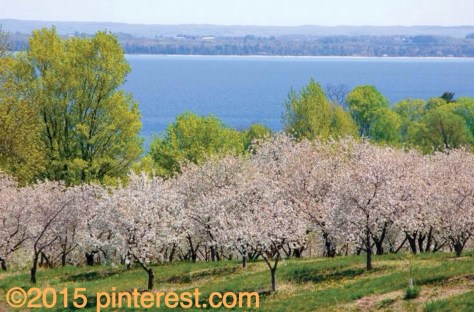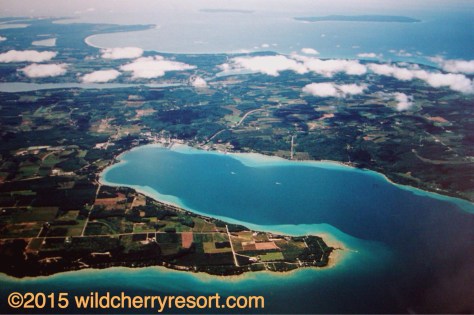
One of our goals in becoming fulltime RVers was to better live out our motto ‘Don’t just see it…BE it!” We’ve always done our best to be a part of where we were visiting during our weekends and summer vacations, but we felt that goal could never fully be accomplished until we could actually spend some quality time in each place. This summer, the time we have spent on the Leelanau peninsula has proven that to us. We had been coming here for years, visiting wineries and exploring the Sleeping Bear Dunes. We honestly were concerned that we had covered the place prior to this summer, and that we would grow tired of being here after six months. Those concerns were soon eased. Leelanau had not revealed all it’s secrets in our past visits…not by a long shot.
Enter the Leelanau Conservancy.
Back in the middle of the twentieth century, this peninsula was a sleepy agricultural domain, dotted with small villages. Sleeping Bear Dunes had yet to be designated a national lakeshore. Few people knew of the natural beauty that exists up here. Even fewer people understood what would happen once the masses discovered Michigan’s little finger. Ed and Bobbie Collins are two of those people. They purchased Leland’s historic Riverside Inn in 1980, restored it, and then operated it until 1988. They became concerned with the subtle development pressures that were beginning to mount, following the establishment of Sleeping Bear Dunes National Lakeshore. They established the Leelanau Conservancy, a non-profit organization aimed at preserving the land and water resources on the peninsula. Their goal was to not only protect undeveloped natural areas outside the national park, but to also preserve the area’s rich agricultural heritage. To date, the conservancy has preserved over 19 square miles of Leelanau County’s 347 square miles of land. 16 square miles are secured with conservation easements, while the other 3 square miles are natural areas owned by the organization. Add to that the 90 square miles protected by the federal government at Sleeping Bear Dunes National Lakeshore and you end up with over a quarter of the county protected from development. And when the land under the villages and roadways is deducted from that remaining square mileage, the unpreserved square mileage starts to shrink. As a result, we aren’t seeing housing developments being built on the tops of the hills, and there is still only one traffic light and one fast food franchise (a Subway in Suttons Bay) in the entire county.
All too often, prime farmland in this country is sold to developers for housing. The high prices offered to the farmers are just too hard to resist. This is where the conservation easements become such a key factor in the Leelanau Conservancy’s efforts. The way they work is like this: the difference in the value of the land between agricultural and subdividing it for homes is determined. The landowner enters into an agreement with the conservancy and attaches a conservation easement to the deed that forever restricts the land from being used for anything other than agricultural purposes. 1/2 of that difference is acquired through federal grants secured by the conservancy and is paid to the landowner. An additional 1/4 is paid to the landowner by the conservancy itself. The final 1/4 is donated by the landowner themselves, even though no money effectively changes hands on that portion. They are then eligible for tax breaks on their property for doing so. The land is still theirs to farm and to sell, but the value is permanently diminished, as the deed will always carry the development restriction. The important thing here is that, while this land is pretty to look at, it is also a highly unique microclimate on the 45th parallel that is prime for growing cherries, apples, hops and grapes. Over half of the nation’s tart cherries come from this region. As older farmers decide to retire, the younger farmers are able to afford to purchase land that would otherwise be too expensive.
And you can only imagine what the cost of the land is after Good Morning America and USA Today recently showcased the area.
So the next question is: where does the conservancy get its money from? Donors….lots and lots of donors. The last annual report online lists ten pages of donors. People up here are serious about keeping development out and protecting this agricultural jewel.
An aerial view of the area shows how important the Leelanau Conservancy is to the county. That sleepy peninsula from the middle of the last century? For the most part, it still exists. In many places, farms still run to the water’s edge. Existing structures are consistently renovated. Agriculture is found in a place you would least expect to find it. Yes, there are a few pockets of unwise development, but they are more the exception than the rule.
Over the next few posts, we will showcase some of the natural areas that the conservancy have been able to protect. The past few weeks, we’ve been able to hike the trails at three of these preserves. What we’ve found has impressed us, as these areas are much more rugged and wild than the trails in the national lakeshore.
Are there similar conservancies that you have discovered in your travels or in your area? We would love to hear about them!




What a cool place, thanks for sharing!
LikeLiked by 1 person
Thanks, Jim!
LikeLike
Beautiful country and always nice to hear about the efforts to keep it that way.
LikeLiked by 1 person
Thanks, Ingrid!
LikeLike
So glad there are so many trying to protect areas:) Thanks for sharing:)
LikeLiked by 1 person
We’re really excited to hike more of their natural areas, Pam and John! Its neat what they are doing.
LikeLike
Great explanation. I never really understood how that worked. The bulk of New Hampshire is still forest because of similar land conservancy initiatives.
LikeLiked by 1 person
There are also different variations of each situation, Trace…such as limits on how many structures can be built on the land.
New Hampshire sure is beautiful!
LikeLike